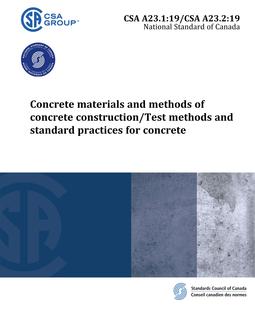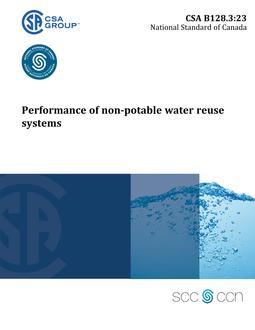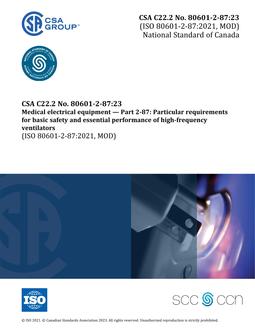
CSA A23.1:19/A23.2:19
Click here to purchase
CSA A23.1:19 – Concrete materials and methods of concrete construction
Scope
1.1 General
This Standard provides the requirements for materials and methods of construction for
a) cast-in-place concrete and concrete precast in the field; and
b) residential concrete used in the construction of buildings conforming to Part 9 of the National Building Code of Canada (NBCC).
1.2 Exclusions
This Standard does not specify the following:
a) requirements for the design of concrete structures, which are provided in CSA A23.3 and CSA S6;
b) designs of specialty concrete products, which are described in separate CSA Group Standards;
c) test methods for concrete, which are provided in CSA A23.2;
d) design provisions governing the fire resistance of reinforced concrete structures, which are set out in the NBCC;
e) requirements for the plant production of precast concrete, which are provided in CSA A23.4; and
f) use of proprietary materials or methods of construction.
Note: Proprietary materials or methods of construction may be permitted by the owner under a separate specification, provided that the quality of the resulting construction meets the minimum requirements of this Standard.
1.3 Precasting of concrete in the field
1.3.1 At the option of the owner, precasting of concrete in the field or in a plant (temporary or permanent) is governed by this Standard or by CSA A23.4, except as limited by Clauses 1.3.2, 1.3.3, and 1.3.4 of this Standard.
Note: Guidelines for such a choice are provided in CSA A23.4.
1.3.2 Precast products that may be produced in accordance with this Standard include conventionally reinforced elements of structures, such as tilt-up walls, stair flights, landings, balcony slabs, lintels, and sills. Products requiring prestressing or post-tensioning are produced in accordance with CSA A23.4.
Note: For references to tilt-up construction, see PCA PA163 and ACI 551R.
1.3.3 If tolerances equivalent to the requirements of CSA A23.4 are desired, then CSA A23.4 is specified for all precasting operations.
1.3.4 The requirements of CSA A23.4 are applicable to pretensioned concrete and precast concrete used in segmental construction.
1.4 Parking garages
For parking garages, the additional requirements of CSA S413 are applicable.
1.5 Supplementary specifications
In addition to the requirements of this Standard, the owner may elect to include supplementary specifications to address proprietary materials and methods of construction, or any other elements not dealt with in this Standard, in order to ensure that the desired quality level is maintained.
1.6 Terminology
In this Standard, “shall” is used to express a requirement, i.e., a provision that the user is obliged to satisfy in order to comply with the Standard; “should” is used to express a recommendation or that which is advised but not required; and “may” is used to express an option or that which is permissible within the limits of the Standard. Notes accompanying clauses do not include requirements or alternative requirements; the purpose of a note accompanying a clause is to separate from the text explanatory or informative material. Notes to tables and figures are considered part of the table or figure and may be written as requirements. Annexes are designated normative (mandatory) or informative (non-mandatory) to define their application.
——————————————————————————————————————————–
CSA A23.2:19 – Test methods and standard practices for concrete
Scope
1.1 General
This Standard covers the principal test methods for hardened and freshly mixed concrete and for concrete materials, as specified in CSA A23.1 and CSA A23.4. The test methods are organized as follows:
a) aggregate test methods;
b) miscellaneous;
c) concrete test methods; and
d) dimensional (moulds).
1.2 Hazards
This Standard does not purport to address the safety problems associated with its use. It is the responsibility of the user of this Standard to establish appropriate safety and health practices and determine the applicability of regulatory limitations prior to use.
Note: Since many users provide individual copies of the test methods for use in the laboratory, the “Hazards” clause is repeated in each test method.
1.3 Dimensions
This Standard is presented in metric units in accordance with CAN/CSA-Z234.1.
Note: The ASTM Standards that are referenced herein are often based on the imperial system, with soft metric equivalents. Where ASTM Standards are referenced, the appropriate metric units in the ASTM Standards should be used wherever possible. When the ASTM Standards refer to other ASTM Standards for which there are equivalent CSA Standards, the latter Standards should be used to ensure a continuity in such things as sieve sizes, metric units, and other particular differences between the Standards.
1.4 Terminology
In this Standard, “shall” is used to express a requirement, i.e., a provision that the user is obliged to satisfy in order to comply with the Standard; “should” is used to express a recommendation or that which is advised but not required; and “may” is used to express an option or that which is permissible within the limits of the Standard. Notes accompanying clauses do not include requirements or alternative requirements; the purpose of a note accompanying a clause is to separate from the text explanatory or informative material. Notes to tables and figures are considered part of the table or figure and may be written as requirements. Annexes are designated normative (mandatory) or informative (non-mandatory) to define their application.
Product Details
- Edition:
- 13th
- Published:
- 06/01/2019
- ISBN(s):
- 9781488307447
- Number of Pages:
- 882
- File Size:
- 1 file , 19 MB
- Product Code(s):
- 2425145, 2425145, 2425145


